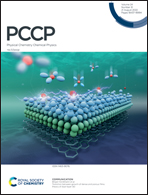Confirmation of gaseous methanediol from state-of-the-art theoretical rovibrational characterization†
Abstract
High-level rovibrational characterization of methanediol, the simplest geminal diol, using state-of-the-art, purely ab initio techniques unequivocally confirms previously reported gas phase preparation of this simplest geminal diol in its C2 conformation. The F12-TZ-cCR and F12-DZ-cCR quartic force fields (QFFs) utilized in this work are among the largest coupled cluster-based anharmonic frequencies computed to date, and they match the experimental band origins of the spectral features in the 980–1100 cm−1 range to within 3 cm−1, representing a significant improvement over previous studies. The simulated spectrum also matches the experimental spectrum in the strong Q branch feature and qualitative shape of the 980–1100 cm−1 region. Additionally, the full set of rotational constants, anharmonic vibrational frequencies, and quartic and sextic distortion constants are provided for both the lowest energy C2 conformer as well as the slightly higher Cs conformer. Several vibrational modes have intensities of 60 km mol−1 or higher, facilitating potential astronomical or atmospheric detection of methanediol or further identification in laboratory work especially now that gas phase synthesis of this molecule has been established.



 Please wait while we load your content...
Please wait while we load your content...